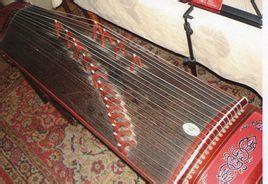The history of Yatoka
Yatoga is a kind of zheng, also known as Mongolian zheng by the Han nationality. It has been widely popular among the people as early as the Spring and Autumn Period and the Warring States Period. It is especially prosperous in the Qin state, known as the Qin zheng in history, and is one of the ancient musical instruments in my country.

Since the Later Han Dynasty, literati and writers have talked about the zheng in official histories and poems and songs. Tang Dynasty poets Li Qiao, Li Bai, Liu Yuxi, Yuan Zhen, Zhang Hu, Li Shangyin, etc. all wrote famous poems for the zheng. In the poets of the prosperous Tang Dynasty, the art of the zheng was vividly depicted, and then it was introduced to Japan in the Tang Dynasty, and then gradually It has become the main instrument of Japanese national music, and has produced many performance genres and famous koto songs.
In 1279, the Mongolian nation established the Yuan Dynasty. The 13-string and 14-string zheng were widely circulated in the court, army and Mongolian people of the Yuan Dynasty.
Yang Weizhen, a famous poet in Yuan Dynasty, not only has the poem "Twelve Feihong Jin Shang Zheng" in "Untitled", he also wrote in "Spring Night Music": "... Shuangzheng sign language Phoenix column, playing with a new sound to express grace Lord. Chaoxing came to dream of a jealous woman, and Shuiyuan immortals blew the sea rain." This shows that at that time, there was already a performance form using two zithers to play against each other. Since the Ming and Qing dynasties, yatokas of different sizes and numbers of strings have been popular in Mongolian folk, palaces or Lama monasteries.
There is a Tang Dynasty zheng (remainder) hidden in the Shoso-in of Todaiji Temple in Nara, Japan. In the "Todaiji Temple Offering Account", there is a "Chengmu zheng". In 1952, it was restored to its full shape according to the remnant, with a total length of 190.85 centimeter.
In 1979, two pieces of "thirteen-string xylophone" were found in Xianyan Spring and Autumn and Warring States Cliffs in Guixi County, Jiangxi Province, which should be the early real objects of the zheng. The shape of the zheng in the past dynasties has not changed much, but the number of strings varies, ranging from twelve to sixteen strings.
 渝公网安备 50010702504639号
渝公网安备 50010702504639号